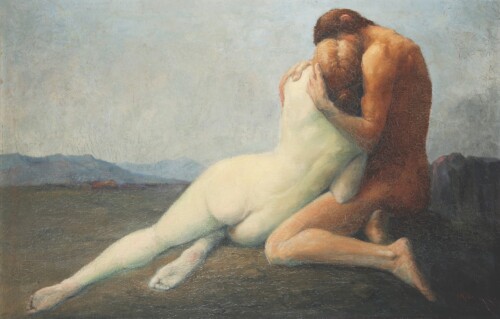| 16 |
Cypriot, 1889-1963
Adam and Eve
oil on canvas
signed lower right
45 x 70 cm
PROVENANCE
private collection, Nicosia
| sold for 25,927.00 € |
During the years the artist spent in Greece and especially the time of his studies at the School of Fine Arts, Athens, Kissonergis was introduced to the work of Nikiforos Lytras and Nikolaos Gyzis. His work was influenced by these two great artists’ academic manner of work.
Adam and Eve, an allegory often depicted in art, literature and poetry, is the subject matter Kissonergis depicts in this painting. A hymn to the beauty of youth placed in a magnificent landscape. The sensuous Eve and muscular Adam is an incarnation of sculpture from classical antiquity, their bodies standing out against the light blue sky radiating a sensuous exuberance.
The bodies of the two figures becoming one sits in the foreground of the picture against an almost infinite landscape, the sky painted as a gentle backdrop to the tender emotional scene, whereas the limited colour palette achieves a sense of divine tranquillity.
Ioannis Kissonergis was born in Nicosia in 1889. His father Pericles Kissonergis was a school teacher, chief cantor at Phaneromeni Church and a teacher of Byzantine music-a broadly cultured personality.
After graduating from Pancyprian Gymnasium in 1907, he moved to Athens where he studied medicine for three years before the outbreak of the Balkan Wars. During the war, his studies were interrupted and between 1912 and 1913 he served as a volunteer doctor for the Greek Red Cross in Thessaloniki.
At the end of the war he ceased his medical studies and enrolled at the School of Fine Arts, Athens, where after studying for one and a half years he became ill with tuberculosis and was forced to give up his studies, due to a law at the time that forbade students with tuberculosis to attend university. During his time at the School of Fine Arts, Athens he was taught by Georgios Jakobides, Dimitrios Geraniotis, Spyridon Vikatos and Georgios Roilos.
He returned to Cyprus and for thirteen years worked as an art teacher for the Pancyprian Gymnasium (1917-1925, 1926-1927, 1932-1935). Unfortunately, in 1935 he was forced to resign because of a new regulation that demanded all teachers be university graduates. He was immediately re-employed by the English School in Nicosia, where he taught until 1952. During his teaching he introduced life class, drawing and painting from nature and gave his students the exercise of copying works of important European painters.
Kissonergis frequently participated in the ‘Cyprus Art Exhibition' organized between 1931 and 1939 and initiated by the then British Governor Sir Roland Storrs to promote Cypriot art.
He held his first solo exhibition in 1952, followed by his second the following year, before immigrating to South Africa with his daughter and son-in-law, where he lived until his death in 1963.
He painted the central dome and half dome of the Phaneromeni Church in Nicosia and the iconostasis of Agia Triada Church in Durban, South Africa in a western spirit influenced by the Renaissance.
Kissonergis lived at a time when the art sector in Cyprus was almost non-existent. The traditional middle class was a small community and individuals that bought art were few. His contribution to educating the public was immeasurable. He is considered the father of contemporary Cypriot art and his contribution to its evolution is considerable.
His work is found in the State Gallery of Contemporary Cypriot Art, the Nicosia Municipality Collection, the Leventis Gallery, the Bank of Cyprus Cultural Centre, the Central Bank of Cyprus Art Collection and many public and private collections in Cyprus and abroad.
